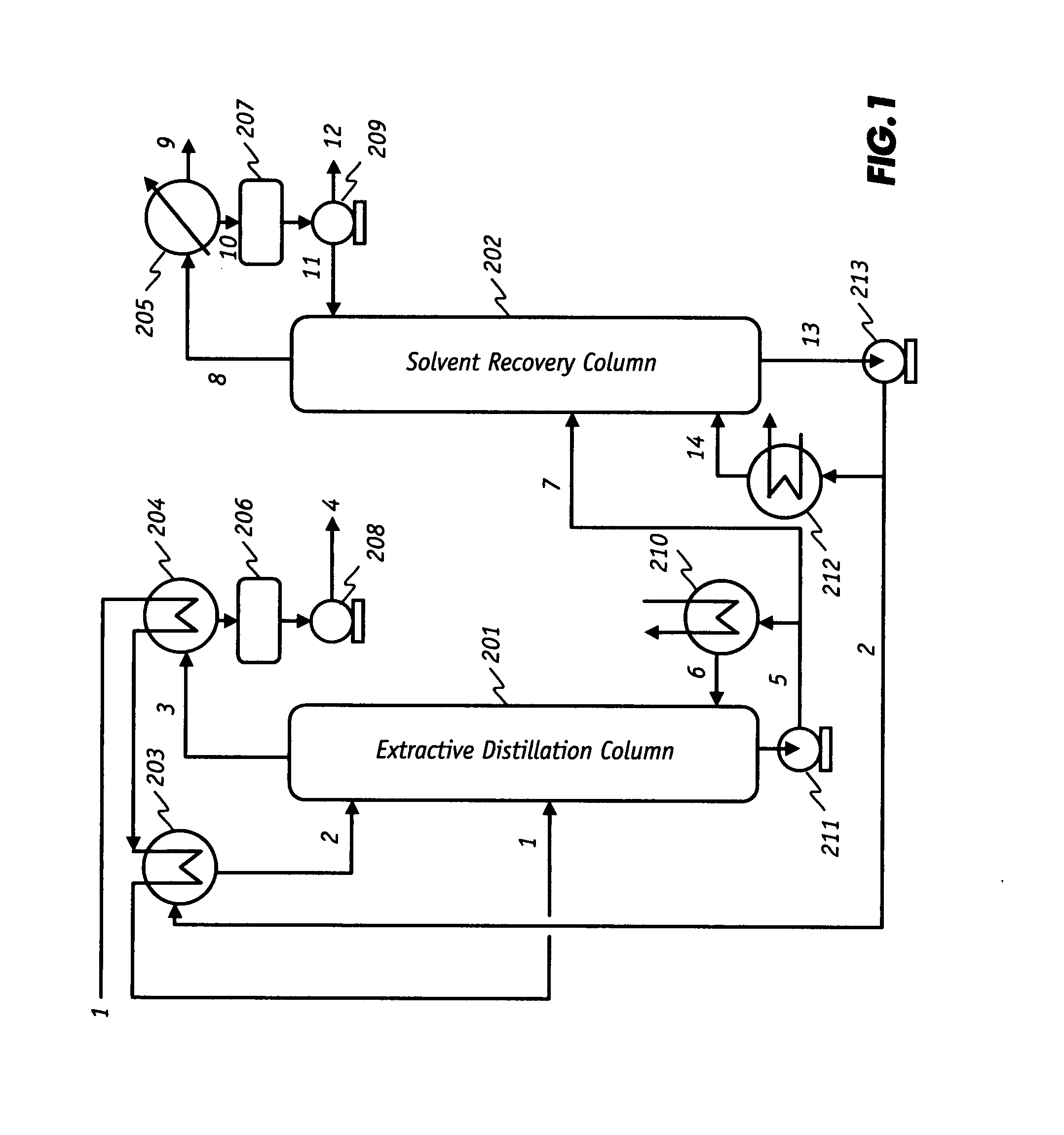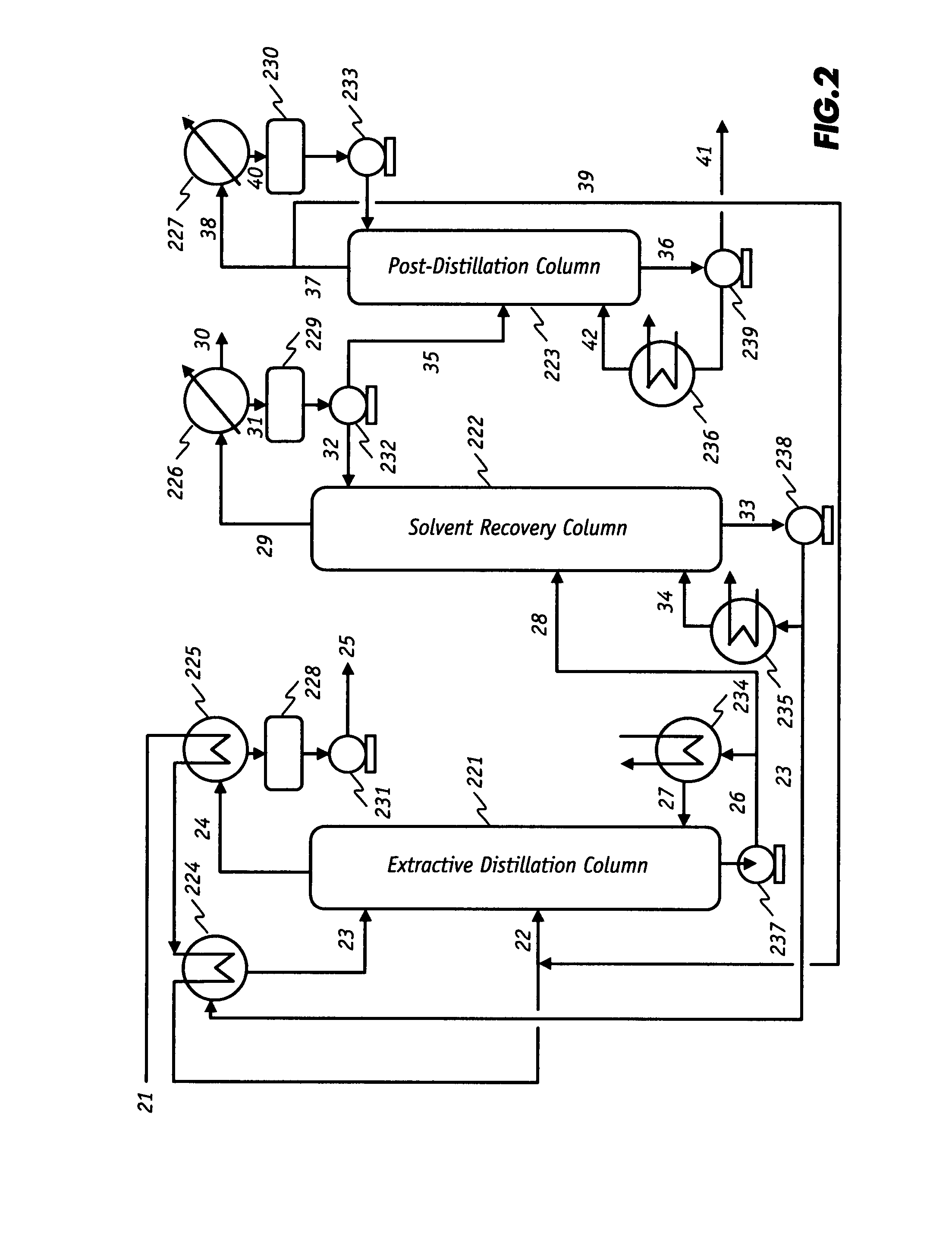Low-energy extractive distillation process for dehydration of aqueous ethanol
- Summary
- Abstract
- Description
- Claims
- Application Information
AI Technical Summary
Benefits of technology
Problems solved by technology
Method used
Image
Examples
example 1
[0084]This example demonstrates that anhydrous ethanol with 99.5 wt % purity and no solvent contamination can be produced from an aqueous ethanol feed in a continuous EDC operating without liquid reflux at the top of the column. Pilot plant tests were carried out in a 3-inch (7.62 cm) diameter continuous EDC which consisted of nine (9) structurally packed sections with a chimney tray at the top of the column. It was estimated that there were four theoretical trays between the lean solvent and the ethanol feed entry points.
[0085]Aqueous feed containing 90.82 wt % ethanol and 9.18 wt % water was pre-heated to 70 to 80° C. and fed into the middle portion of the EDC (4th section from the bottom). A lean solvent containing 99.50 wt % glycerin and 0.50 wt % water was fed to the chimney tray at the top of the column after pre-heating. The rates of ethanol feed and glycerin solvent feed were 1.94 and 7.39 Kg / h, respectively (the overall solvent-to-feed (S / F) weight ratio was 3.8). Allowing ...
example 2
[0087]This example demonstrates that significant energy can be saved by eliminating liquid reflux at the top of an EDC without sacrificing anhydrous ethanol purity or product recovery.
[0088]Approximately 100 kg / h of aqueous ethanol at 25° C. was fed to tray 12 (counting from the top) and 350 kg / h of glycerin solvent at 45° C. was introduced to tray 3 of an EDC consisting of 13 theoretical trays (excluding the kettle). The aqueous ethanol feed contained 90 wt % ethanol and 10 wt % water and the glycerin solvent feed contained 99.7 wt % glycerin and 0.3 wt % water. The EDC was operated with no liquid reflux and alternatively with a liquid reflux ratio (R / D) of 1.0 to compare the energy requirements of the EDC. In both cases, the column temperature increased from 78° C. at the top (tray 1) to 128° C. at the bottom (tray 13), while the column pressure increased from 1.00 to 1.25 atmospheres through the top to the bottom. The EDC kettle operated at 175° C. and 1.27 atmospheres.
[0089]Unde...
example 3
[0090]This ED process simulation result demonstrates that significant energy can be saved by employing partial ethanol recovery in an EDC and recovering the lost ethanol in a front-end pre-distillation (beer) column. The process simulator was upgraded and validated by the experimental data from an ED commercial demonstration plant. Specifically, a small fraction of ethanol in ethanol feed stream to the EDC is allowed to be lost to the bottom (rich solvent) stream of the EDC. As shown in FIG. 4, the lost ethanol is then recycled and recovered in a front-end pre-distillation column where the VLE curve of ethanol / water is extremely favorable for distillation. This novel process configuration not only reduces the overall process energy requirements, but also allows the EDC to be operated under relatively mild conditions.
[0091]In accordance with the process shown to FIG. 4, 12,600 kg / h of fermentation broth containing 12 wt % ethanol and 88 wt % water is introduced into the process via l...
PUM
| Property | Measurement | Unit |
|---|---|---|
| Temperature | aaaaa | aaaaa |
| Temperature | aaaaa | aaaaa |
| Temperature | aaaaa | aaaaa |
Abstract
Description
Claims
Application Information
 Login to View More
Login to View More - R&D
- Intellectual Property
- Life Sciences
- Materials
- Tech Scout
- Unparalleled Data Quality
- Higher Quality Content
- 60% Fewer Hallucinations
Browse by: Latest US Patents, China's latest patents, Technical Efficacy Thesaurus, Application Domain, Technology Topic, Popular Technical Reports.
© 2025 PatSnap. All rights reserved.Legal|Privacy policy|Modern Slavery Act Transparency Statement|Sitemap|About US| Contact US: help@patsnap.com



